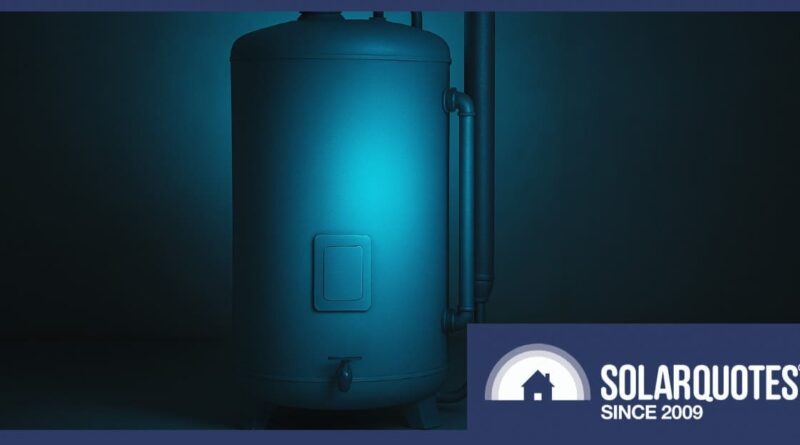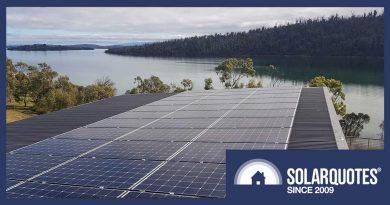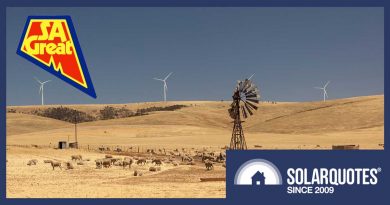The Future of Hot Water Is Finnish Rocks

 Finnish company Peikkovoima held its Australian launch of a revolutionary new form of home hot water in Adelaide last night. Using a process called geological decomposition, the company promises their system will provide household hot water in a way that’s environmentally benign and affordable.
Finnish company Peikkovoima held its Australian launch of a revolutionary new form of home hot water in Adelaide last night. Using a process called geological decomposition, the company promises their system will provide household hot water in a way that’s environmentally benign and affordable.
A New Type Of Hot Water
In the past, if you wanted scalding hot water for your home but didn’t want a scalding hot planet, your options were limited to:
- Solar hot water;
- A heat pump or conventional electric hot water system powered by rooftop solar.
But Peikkovoima offers a 3rd way that makes use of the high decomposition heat of specific minerals. This allows them to offer a system that can provide hot water for a prolonged period of time without any external energy source.
I tried to make sense of the technical information on the Peikkovoima site but couldn’t understand a word of it. It may as well have been written in Finnish. In fact, I suspect it was. I did translate it, but it still made no sense. Luckily, I was able to go straight to the source and get information directly from Peikkovoima’s two founders and gain some interesting insights into the technology, the company, and — unfortunately — Finnish culture.
Peikkovoima — An Interview
I had the pleasure of interviewing Karvainen Hämähäkki and Sikha Koria, the founders of Peikkovoima, at their product launch last night. Here’s how it went, with a few “ums” and “ahs” edited out:
SOLARQUOTES (SQ): It’s a pleasure to meet you. To begin, could you give me some background information on your company?
HÄMÄHÄKKI: Certainly. It would be a pleasure for me. Peikkovoima began a little over two years ago. As you may know, Finland is famous for its hot springs…
SQ: No.
HÄMÄHÄKKI: Surely you have heard how we love our hot saunas in Finland?
SQ: Yeah, but none of them are hot springs. Finland is primarily Paleoproterozoic and Archean craton with no geothermal activity for heating spring water. Also, Finland is famous for its almost complete lack of groundwater. I know because my mother’s PHD was on cratons and how boring they are.
HÄMÄHÄKKI: Yes, but the few hot springs we have are famous because they are so rare and because they are not formed from geothermal heat, but from geological decomposition of minerals.
SQ: Oh! I didn’t know about this. Please go on.
HÄMÄHÄKKI: To go on would also be a pleasure. In the Loviisa region of Finland, my business compatriot, Mr Koria, salvaged a supply of these minerals…
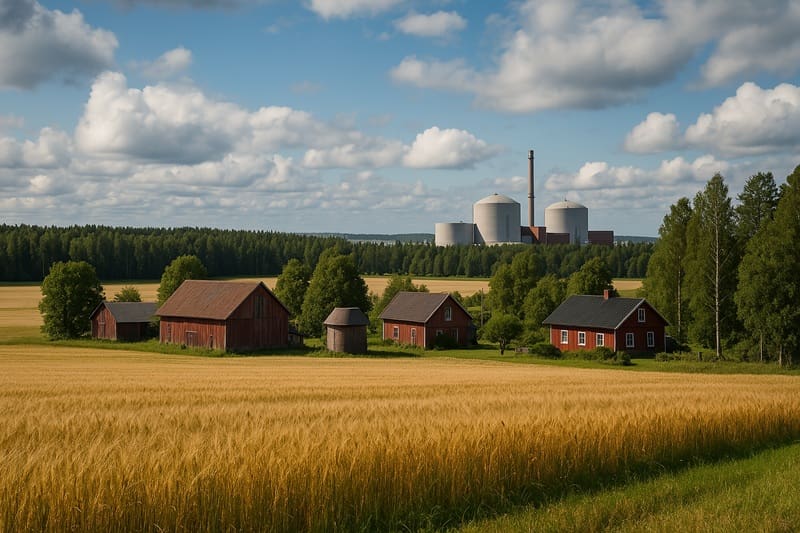
The Loviisa region in Finland. (SQ Founder Finn Peacock’s uncle lives in the building behind the barn — and get this — his name is “Seppo”.)
SQ: Salvaged?
KORIA: They “putosi kuorma-auton selästä.”
HÄMÄHÄKKI: He claimed a right to? Staked a claim to? My English is not so good. So, he approached me to discuss how this could be monetised.
KORIA: First, we tried the hot springs business.
HÄMÄHÄKKI: Yes, but we decided this approach was not the best.
KORIA: The filter kept getting clogged with hair.
HÄMÄHÄKKI: So then we settled on the hot water system.
SQ: So, how does geological decomposition hot water work?
HÄMÄHÄKKI: To tell you this would also pleasure me. As you may know, when certain chemical bonds break, they release heat energy. These minerals we are using are breaking into really very small pieces now and so release large amounts of heat.
SQ: So how much electrical power does it need?
HÄMÄHÄKKI: It requires no external power. It provides all its own heat, guaranteed for 10 years.
SQ: But there’s a power cord coming out of that unit right there!
KORIA: That’s not a power cord. It’s a tail. It’s “joten paholainen tuntee omansa.” For good luck. The three metal prongs on the end represent the Father, the Son, and his other Son, Toby.
HÄMÄHÄKKI: Let me explain. This is the Finnish model with a winter power boost. In Australia it’s not necessary and so we can offer it at a much lower price.
SQ: I see. But if it can provide 10 years of power without any additional input, it must contain a massive amount of the mineral.
HÄMÄHÄKKI: You might be surprised.
SQ: Can I look inside?
HÄMÄHÄKKI: Of course. This is a demonstration model. The lid lifts right off. It is perfectly safe.
KORIA: Provided there is at least 40cm of water between you and the rocks.
SQ (Lifting lid): Wow! That’s a really tiny amount of rock! How does it manage to put out enough heat to last 10 years? And why are you over there now?
HÄMÄHÄKKI (From across the room): I am sorry, we thought we saw one of your Australian spiders. They are very hairy and frightening. Put the lid down and we will come back over.
SQ: The tiny amount of mineral in there must be putting out an enormous amount of energy to heat all that water. It would have to be a hell of an exothermic reaction. What’s to stop it from getting out of control or exploding?
HÄMÄHÄKKI: It cannot… explode.
SQ: Why did you pause just then?
HÄMÄHÄKKI: I did not… pause.
SQ: But can it be dangerous?
HÄMÄHÄKKI: There is zero danger. It is self-limiting and the heat output will gradually reduce, but we guarantee hot water for 10 years minimum. And if you order now, it’s only $6,000 per unit.
SQ: Only $6,000? That’s a good deal for people who can’t install solar, but for solar households it doesn’t beat the cost of heat pump hot water.
KORIA: Okay, for you, $5,000.
HÄMÄHÄKKI: People will have to decide for themselves if it is worthwhile. But we also guarantee that it is 100% Legionairres safe and will remain completely free of biofilm buildup for the life of the system.
SQ: Completely free of biofilm for as long as it lasts? That is impressive.
KORIA: Nothing survives inside our water heaters!
SQ: I was very impressed with how the mineral was giving off a blue glow. Do you think you could sell it as a nightlight or a decoration for aquariums?
KORIA: Not even I would do that!
HÄMÄHÄKKI: We think that keeping the mineral in the hot water system is a… longer life business plan.
SQ: So, have you sold many systems?
HÄMÄHÄKKI: Oh yes, we have many orders.
KORIA: We have so many orders, I am thinking of quitting my job at my uncle’s waste disposal business.
HÄMÄHÄKKI: A Peikkovoima hot water system has already been installed in Australia. We gave one to your President, Mr. Dutton.
SQ: Did he express an interest?
KORIA: No, it’s just that, for some reason, his house is already lead-lined.
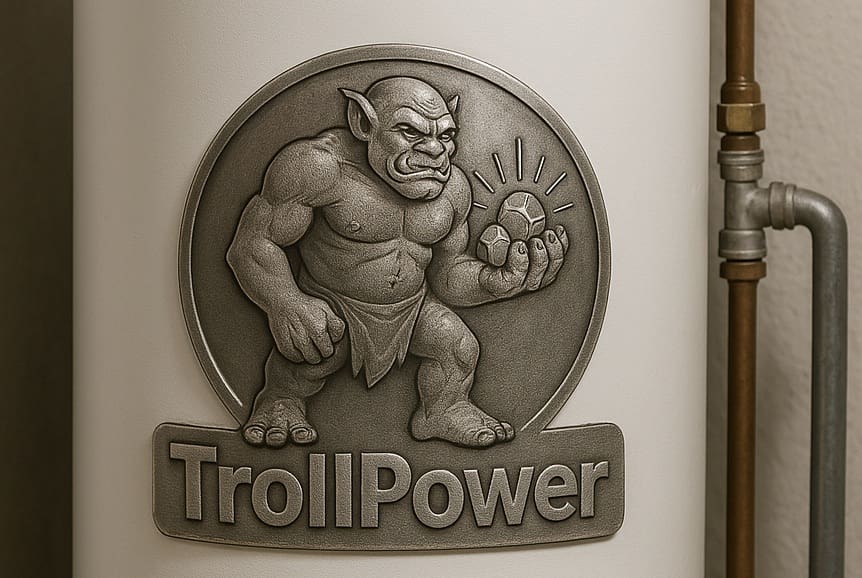
Peikkovoima will launch in Australia under the English translation of their brand name: TrollPower.
The End Of The Interview
I had to stop the interview there, but hopefully, Peikkovoima hot water systems, with their new geological decomposition technology, will soon be available for purchase and provide another environmentally friendly option for hot water.
Unfortunately, their arrival on the market may be delayed. I had to end the interview suddenly because a woman standing near us pulled a device from her pocket that emitted clicking noises. Then she announced she was from ANTSO and that all the hot water systems were impounded.
While this was an unfortunate start to Peikkovoima’s business in Australia, I was glad to see firsthand that Australian Customs is doing its part to protect us from ants. We already have too many invasive species here and we don’t need any from Finland.
I even think I must have been stung, because I have a rash on my hand and face…
Original Source: https://www.solarquotes.com.au/blog/the-future-of-hot-water-is-finnish-rocks/

